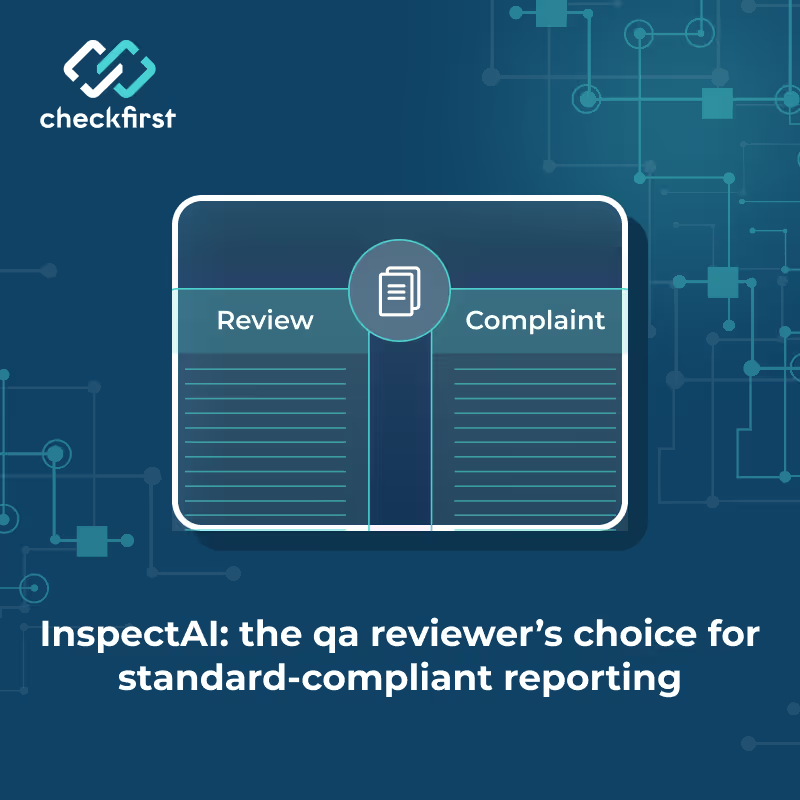



You review dozens of inspection reports every week. Half come back with missing photos, incomplete data, or format errors. Sound familiar? Quality control software like InspectAI changes this completely. QA reviewers using this AI inspection tool see about 48% faster report processing and fewer rejections. Your review process becomes predictable instead of frustrating.
Managing report quality across multiple inspection teams creates constant hurdles for QA professionals. You know the routine. Reports arrive on your desk with problems that slow down your entire workflow. One certification company, Checkfirst works with, found that 80% of their report rejections came from administrative errors rather than actual compliance issues.
You might also be facing these common challenges regularly:
The pressure builds when clients demand faster turnaround times. You can't speed up reviews when reports need constant rework. This creates a challenge that affects your entire operation.
Related Post: Can AI inspection help auditors and inspectors capture accurate data the first time?
Paper-based processes and manual workflows make consistent quality control nearly impossible. They put too much responsibility on individual inspector judgment. This creates gaps that you must catch during review, making your job reactive instead of proactive.
Major problems with manual processes include:
You discover these problems only after they reach your desk for review. This makes quality control a time-consuming process of finding and fixing issues instead of preventing them.
Related Post: AI workflow automation: How InspectAI gives certification leaders full control over certification workflows
Quality control software like InspectAI addresses every major pain point in your review workflow. The system prevents problems before they reach you. Instead of catching errors during review, the platform stops incomplete or non-compliant submissions at the source.
Key transformation benefits:
Standardized templates mean every report looks the same. ISO audits, safety inspections, compliance checks - they all follow the same format. You know exactly where to find what you need, so reviews go much faster.
AI visual inspection automatically confirms that photos contain the required elements. Blurry images, missing equipment shots, or incorrect angles get flagged before submission. You never waste time requesting better photos again.
Related Post: How InspectAI makes audit workflows up to 5X more efficient for TICC companies
Companies using InspectAI see immediate improvements in report quality and review efficiency.
A Brazilian certification company with 50 auditors transformed their entire QA process. Their results show what's possible when quality control moves from reactive to proactive.
Measurable improvements achieved:
Another global inspection marketplace with 200,000 inspectors experienced similar results. More importantly for QA reviewers, they saw major improvements in report consistency. Every submission met their quality standards regardless of the inspector's experience level.
QA managers reported that the standardized process eliminated frustrating back-and-forth communication about missing information. Teams could focus on actual compliance issues instead of fixing basic documentation problems.
Related Post: Why TICC businesses are choosing InspectAI for smarter inspections and audits
Quality control software designed for TICC professionals includes specific tools that make your job easier.
Quality control software implementation usually shows results within the first week of use.
Most QA teams see immediate improvements in report quality and consistency. The Brazilian certification company started seeing results during their first inspections. Their review time dropped from hours to minutes per report.
Cost savings come from multiple sources. Less rework means faster project completion. Consistent quality reduces client complaints and revision requests. Your team processes more reports with the same resources.
The learning curve is minimal for both inspectors and reviewers. The system guides users through familiar processes while adding quality controls. Most teams adapt quickly without extensive training periods.
QA teams turn to quality control software like InspectAI because it tackles their biggest challenges. No partially filled reports, missing uniformity in formats, and never-ending revision cycles.
The platform ensures standard-compliant submissions by all inspectors every time. Your review process becomes efficient and predictable, letting you focus on actual quality issues instead of administrative problems. Connect with Checkfirst today to get started with InspectAI now.
Pricing depends on your team size and inspection volume. Contact Checkfirst for a quote that fits your specific quality control needs and requirements.
Most QA teams start using InspectAI effectively within a few days. The interface follows familiar inspection processes, so your learning curve stays very minimal.
Yes, all data gets encrypted and meets industry security standards. InspectAI follows strict protocols to protect your sensitive inspection information and valuable client data.
Yes, Checkfirst offers demos and trial periods for QA teams. You can test InspectAI with your actual workflows before making any final purchasing decisions.
Most teams see immediate improvements in report quality and consistency. You'll notice fewer rejections and faster reviews within your very first week of use.